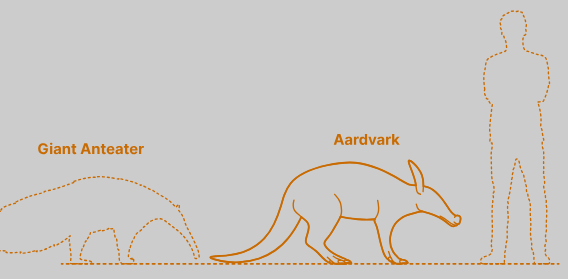Aardvark: The Enigmatic Anteater of the African Savanna”
The African savanna, with its vast landscapes and diverse wildlife, is home to one of the most intriguing creatures known to man – the aardvark. With its unique appearance and peculiar habits, the aardvark has captivated the curiosity of scientists and nature enthusiasts alike. In this article, we will delve into the fascinating world of the aardvark, exploring its characteristics, behavior, and its vital role in the ecosystem.
Appearance and Anatomy: The aardvark, scientifically known as Orycteropus afer, is a medium-sized mammal that stands out with its distinct appearance. Covered in coarse, bristly hair that ranges from gray to reddish-brown, the aardvark has a robust body and a long snout. Its most prominent feature is its tubular, elongated nose, reminiscent of a vacuum cleaner attachment, which is well-adapted for its unique feeding habits.
The aardvark’s powerful claws are perfect for digging, and it boasts a large, sticky tongue that can extend up to 30 centimeters, ideal for extracting its favorite meal – ants and termites. Despite its seemingly cumbersome physique, the aardvark is surprisingly agile and can move swiftly when needed.
Habitat and Distribution: Aardvarks are primarily found in sub-Saharan Africa, inhabiting a range of environments from grasslands to forests, but they are most commonly associated with the savanna. These nocturnal creatures prefer regions with loose, sandy soil, which aids in their burrowing activities. Aardvarks construct complex burrow systems using their powerful claws, creating a network of underground tunnels where they spend much of their daylight hours.
Nocturnal Lifestyle: Aardvarks are predominantly nocturnal, meaning they are most active during the night. This behavior is believed to be an adaptation to avoid the scorching daytime temperatures of the African savanna. During the night, aardvarks emerge from their burrows in search of their favorite food – termites and ants. Their keen sense of smell helps them locate insect colonies, and once detected, they use their powerful claws to excavate the insects from their mounds.
While primarily solitary, aardvarks may occasionally form loose colonies, especially during mating season. These colonies, however, do not involve social interactions between individuals, as aardvarks are generally solitary creatures.
Diet and Feeding Behavior: The aardvark’s diet is highly specialized, consisting almost entirely of ants and termites. Its elongated tongue is perfectly adapted for extracting insects from their nests, and its strong claws allow it to break into termite mounds and ant hills with ease. Despite being equipped with formidable digging and burrowing skills, aardvarks are not adept predators and rely solely on insects for sustenance.
Their feeding habits contribute to the control of termite and ant populations in the ecosystem, making them an essential species for maintaining a balanced environment. Aardvarks play a crucial role in regulating insect populations, preventing unchecked growth that could have detrimental effects on vegetation and soil health.
Reproduction and Life Cycle: Aardvarks reach sexual maturity at around two years of age, and mating typically occurs during the dry season. Female aardvarks have a gestation period of about seven months, after which a single cub is born. The mother provides care and protection for her offspring within the safety of their burrow.
Aardvark cubs are born with closed eyes and ears, and they remain in the burrow for several weeks until they are developed enough to accompany their mother on foraging expeditions. The mother teaches her young the necessary skills for survival, including digging for food and constructing burrows.
Conservation Status and Threats: While aardvarks are not currently classified as endangered, they face various threats that could impact their populations in the future. Habitat loss due to human activities, such as agriculture and infrastructure development, poses a significant challenge for aardvarks. Additionally, they are vulnerable to predators like lions, leopards, and hyenas, especially when they are outside their burrows.
Efforts to conserve aardvark populations involve habitat protection, addressing human-wildlife conflicts, and promoting sustainable land use practices. Continued research on aardark behavior and ecology is essential for developing effective conservation strategies.
In conclusion
the aardvark, with its unique appearance, specialized diet, and intriguing behaviors, stands as a testament to the diversity of life in the African savanna. As stewards of the Earth, it is our responsibility to understand, appreciate, and conserve these remarkable creatures, ensuring that they continue to thrive in their natural habitats for generations to come.

